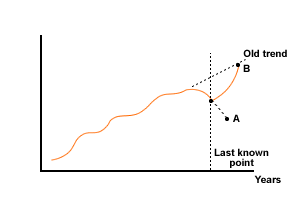Constructing time-series analysis
How do we construct a time series analysis? Very carefully, is the answer, especially when it comes to drawing conclusions! The main methods used are:
- Free hand sketching
- Moving averages
Freehand sketching
This is self-explanatory. Plot the data and fit the 'best' line by eye. This method is not as useless as it looks. It gives a first approximation, and may also be the best that can be done.
Be very careful when a pattern that has become established changes. Look at the sales forecast below.

Figure 3 Possible sales forecast
Sales and profits have risen for years, but suddenly there is a fall. Is it an error, a blip, or what? What will be the forecast for next year? Will it be A or B? The message is watch carefully, and analyse even more carefully what happened last year. It is too easy to read into the forecast what you want to see, and then justify it.
Click on the right arrow at the top or bottom of the page to look at the second of these techniques - moving average.